Accounting Policies and Sustainability Reporting: BlueScope Steel
VerifiedAdded on 2022/11/09
|6
|1450
|353
Report
AI Summary
This report provides a comprehensive analysis of BlueScope Steel's accounting policies and sustainability reporting, based on its 2017/2018 annual and corporate social responsibility reports. The report addresses the measurement and recognition of Property, Plant, and Equipment (PPE), comparing accounting policies for each PPE class. It examines the governance mechanisms related to sustainability, including the role of the Board of Directors and the Risk and Sustainability Committee. The report explores BlueScope's risk management system and its integration into sustainability reporting, along with the company's approach to implementing social and environmental performance and reporting systems. It also compares the variations in voluntary disclosure across different industries and companies, highlighting how ethical considerations and stakeholder expectations influence these decisions. The analysis references key accounting standards and provides insights into BlueScope's financial and ethical strategies, making it a valuable resource for understanding corporate accounting and sustainability practices.
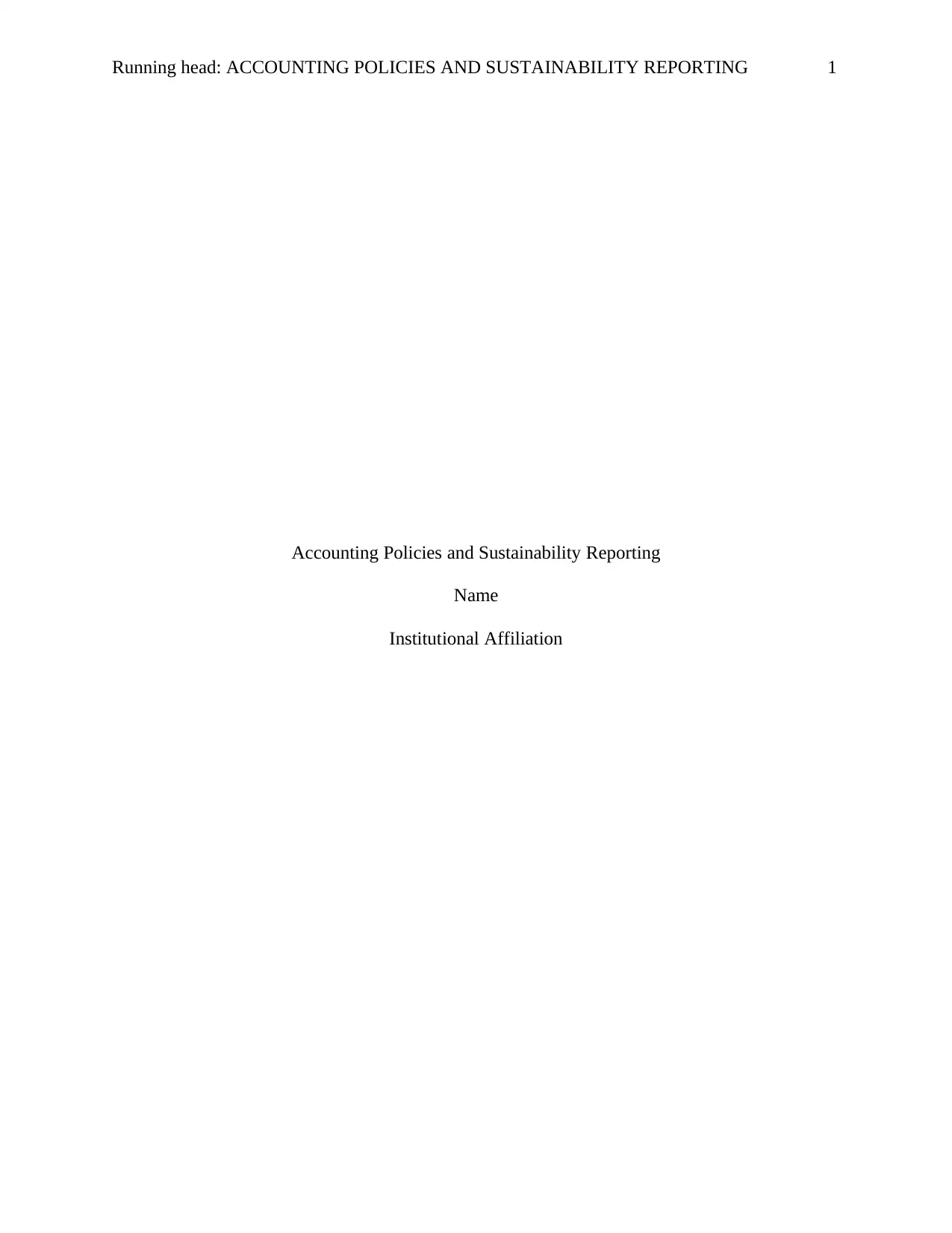
Running head: ACCOUNTING POLICIES AND SUSTAINABILITY REPORTING 1
Accounting Policies and Sustainability Reporting
Name
Institutional Affiliation
Accounting Policies and Sustainability Reporting
Name
Institutional Affiliation
Paraphrase This Document
Need a fresh take? Get an instant paraphrase of this document with our AI Paraphraser
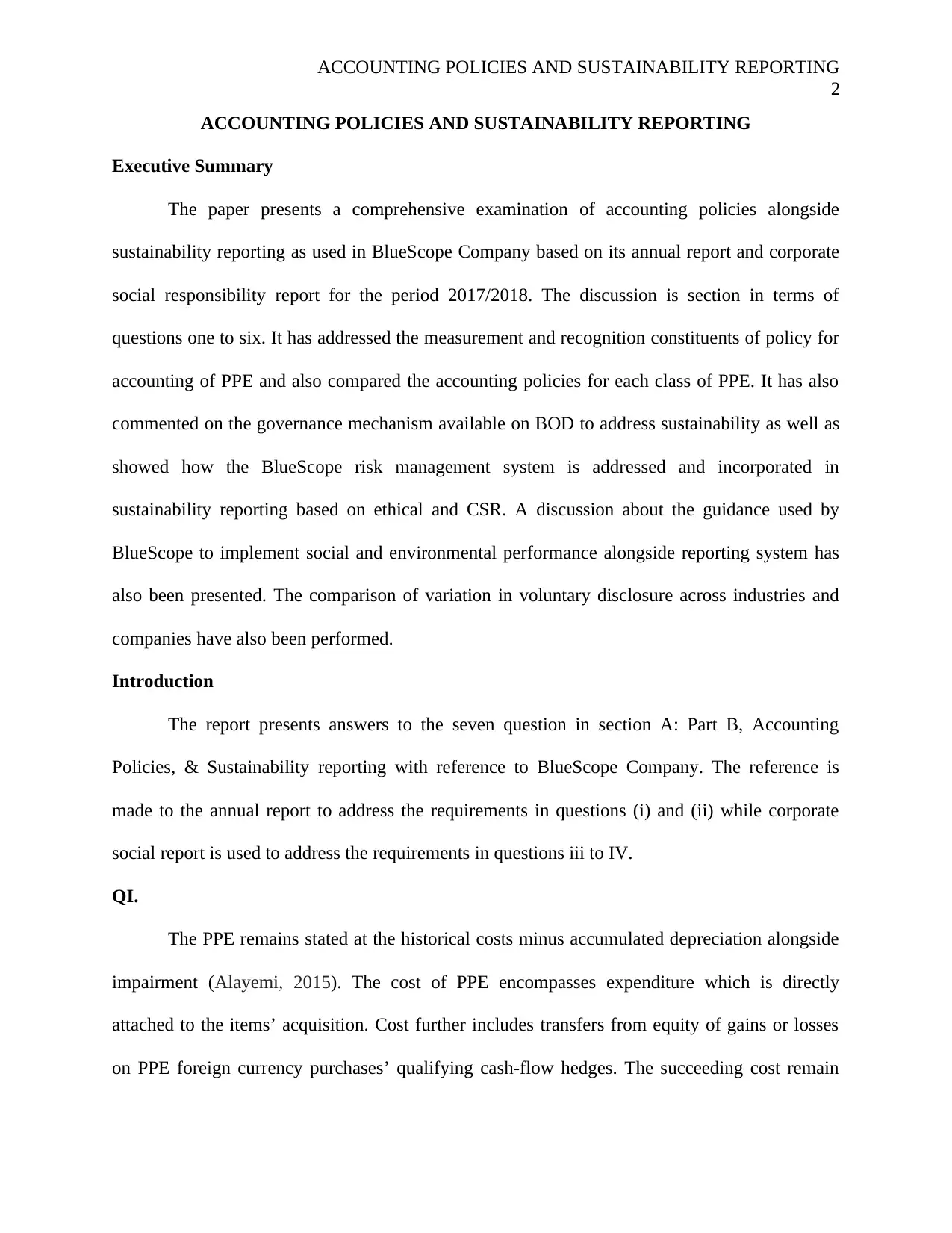
ACCOUNTING POLICIES AND SUSTAINABILITY REPORTING
2
ACCOUNTING POLICIES AND SUSTAINABILITY REPORTING
Executive Summary
The paper presents a comprehensive examination of accounting policies alongside
sustainability reporting as used in BlueScope Company based on its annual report and corporate
social responsibility report for the period 2017/2018. The discussion is section in terms of
questions one to six. It has addressed the measurement and recognition constituents of policy for
accounting of PPE and also compared the accounting policies for each class of PPE. It has also
commented on the governance mechanism available on BOD to address sustainability as well as
showed how the BlueScope risk management system is addressed and incorporated in
sustainability reporting based on ethical and CSR. A discussion about the guidance used by
BlueScope to implement social and environmental performance alongside reporting system has
also been presented. The comparison of variation in voluntary disclosure across industries and
companies have also been performed.
Introduction
The report presents answers to the seven question in section A: Part B, Accounting
Policies, & Sustainability reporting with reference to BlueScope Company. The reference is
made to the annual report to address the requirements in questions (i) and (ii) while corporate
social report is used to address the requirements in questions iii to IV.
QI.
The PPE remains stated at the historical costs minus accumulated depreciation alongside
impairment (Alayemi, 2015). The cost of PPE encompasses expenditure which is directly
attached to the items’ acquisition. Cost further includes transfers from equity of gains or losses
on PPE foreign currency purchases’ qualifying cash-flow hedges. The succeeding cost remain
2
ACCOUNTING POLICIES AND SUSTAINABILITY REPORTING
Executive Summary
The paper presents a comprehensive examination of accounting policies alongside
sustainability reporting as used in BlueScope Company based on its annual report and corporate
social responsibility report for the period 2017/2018. The discussion is section in terms of
questions one to six. It has addressed the measurement and recognition constituents of policy for
accounting of PPE and also compared the accounting policies for each class of PPE. It has also
commented on the governance mechanism available on BOD to address sustainability as well as
showed how the BlueScope risk management system is addressed and incorporated in
sustainability reporting based on ethical and CSR. A discussion about the guidance used by
BlueScope to implement social and environmental performance alongside reporting system has
also been presented. The comparison of variation in voluntary disclosure across industries and
companies have also been performed.
Introduction
The report presents answers to the seven question in section A: Part B, Accounting
Policies, & Sustainability reporting with reference to BlueScope Company. The reference is
made to the annual report to address the requirements in questions (i) and (ii) while corporate
social report is used to address the requirements in questions iii to IV.
QI.
The PPE remains stated at the historical costs minus accumulated depreciation alongside
impairment (Alayemi, 2015). The cost of PPE encompasses expenditure which is directly
attached to the items’ acquisition. Cost further includes transfers from equity of gains or losses
on PPE foreign currency purchases’ qualifying cash-flow hedges. The succeeding cost remain
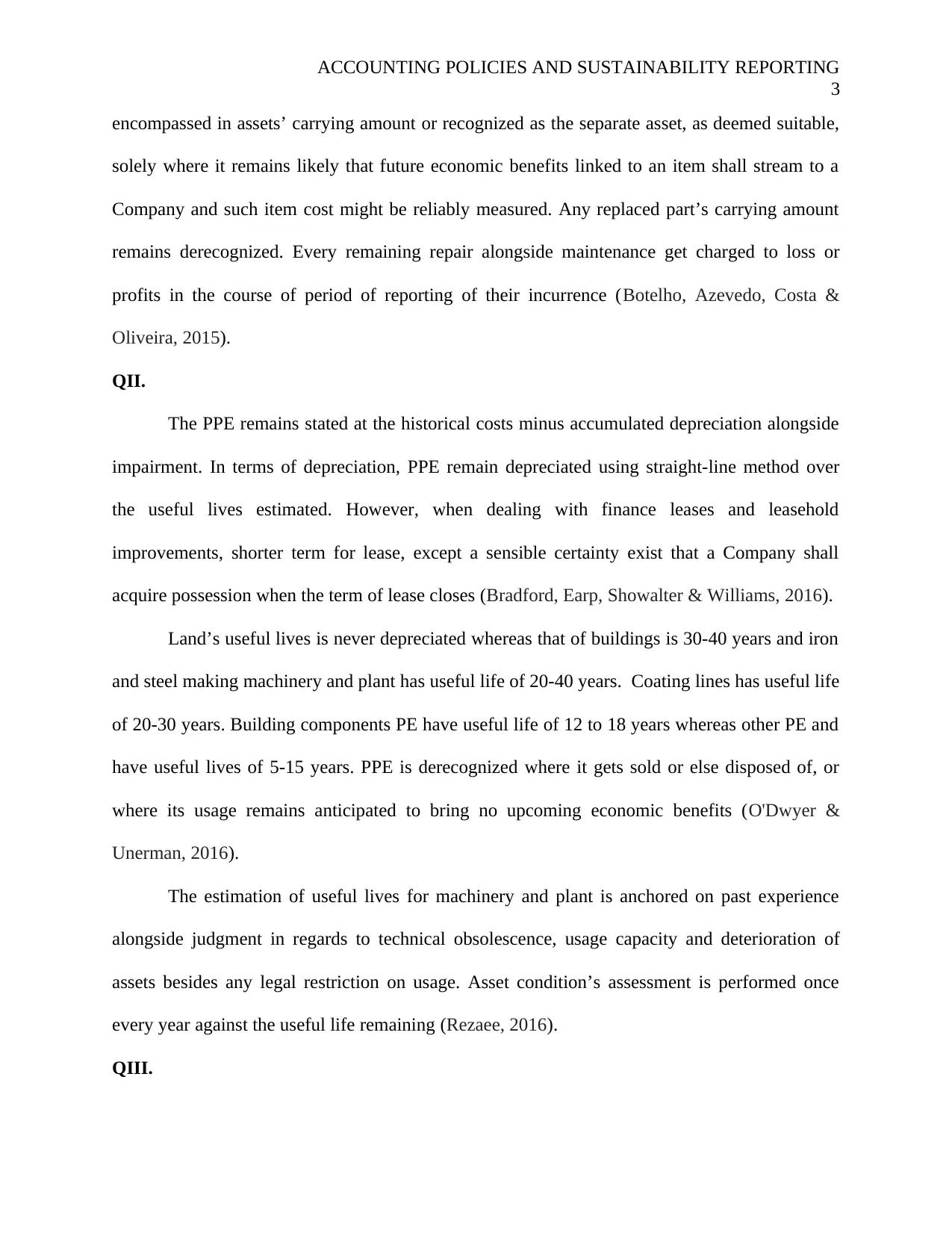
ACCOUNTING POLICIES AND SUSTAINABILITY REPORTING
3
encompassed in assets’ carrying amount or recognized as the separate asset, as deemed suitable,
solely where it remains likely that future economic benefits linked to an item shall stream to a
Company and such item cost might be reliably measured. Any replaced part’s carrying amount
remains derecognized. Every remaining repair alongside maintenance get charged to loss or
profits in the course of period of reporting of their incurrence (Botelho, Azevedo, Costa &
Oliveira, 2015).
QII.
The PPE remains stated at the historical costs minus accumulated depreciation alongside
impairment. In terms of depreciation, PPE remain depreciated using straight-line method over
the useful lives estimated. However, when dealing with finance leases and leasehold
improvements, shorter term for lease, except a sensible certainty exist that a Company shall
acquire possession when the term of lease closes (Bradford, Earp, Showalter & Williams, 2016).
Land’s useful lives is never depreciated whereas that of buildings is 30-40 years and iron
and steel making machinery and plant has useful life of 20-40 years. Coating lines has useful life
of 20-30 years. Building components PE have useful life of 12 to 18 years whereas other PE and
have useful lives of 5-15 years. PPE is derecognized where it gets sold or else disposed of, or
where its usage remains anticipated to bring no upcoming economic benefits (O'Dwyer &
Unerman, 2016).
The estimation of useful lives for machinery and plant is anchored on past experience
alongside judgment in regards to technical obsolescence, usage capacity and deterioration of
assets besides any legal restriction on usage. Asset condition’s assessment is performed once
every year against the useful life remaining (Rezaee, 2016).
QIII.
3
encompassed in assets’ carrying amount or recognized as the separate asset, as deemed suitable,
solely where it remains likely that future economic benefits linked to an item shall stream to a
Company and such item cost might be reliably measured. Any replaced part’s carrying amount
remains derecognized. Every remaining repair alongside maintenance get charged to loss or
profits in the course of period of reporting of their incurrence (Botelho, Azevedo, Costa &
Oliveira, 2015).
QII.
The PPE remains stated at the historical costs minus accumulated depreciation alongside
impairment. In terms of depreciation, PPE remain depreciated using straight-line method over
the useful lives estimated. However, when dealing with finance leases and leasehold
improvements, shorter term for lease, except a sensible certainty exist that a Company shall
acquire possession when the term of lease closes (Bradford, Earp, Showalter & Williams, 2016).
Land’s useful lives is never depreciated whereas that of buildings is 30-40 years and iron
and steel making machinery and plant has useful life of 20-40 years. Coating lines has useful life
of 20-30 years. Building components PE have useful life of 12 to 18 years whereas other PE and
have useful lives of 5-15 years. PPE is derecognized where it gets sold or else disposed of, or
where its usage remains anticipated to bring no upcoming economic benefits (O'Dwyer &
Unerman, 2016).
The estimation of useful lives for machinery and plant is anchored on past experience
alongside judgment in regards to technical obsolescence, usage capacity and deterioration of
assets besides any legal restriction on usage. Asset condition’s assessment is performed once
every year against the useful life remaining (Rezaee, 2016).
QIII.
⊘ This is a preview!⊘
Do you want full access?
Subscribe today to unlock all pages.

Trusted by 1+ million students worldwide
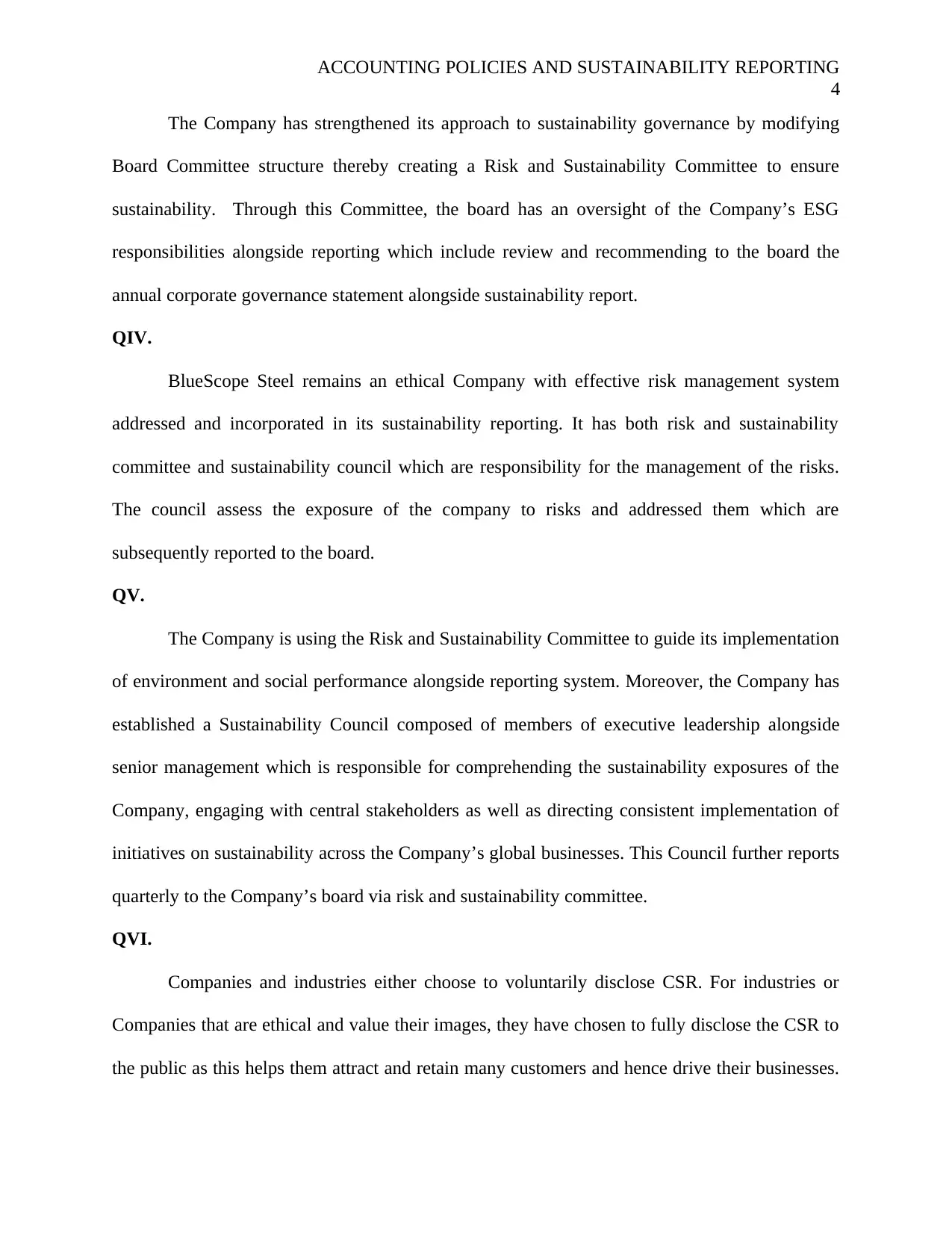
ACCOUNTING POLICIES AND SUSTAINABILITY REPORTING
4
The Company has strengthened its approach to sustainability governance by modifying
Board Committee structure thereby creating a Risk and Sustainability Committee to ensure
sustainability. Through this Committee, the board has an oversight of the Company’s ESG
responsibilities alongside reporting which include review and recommending to the board the
annual corporate governance statement alongside sustainability report.
QIV.
BlueScope Steel remains an ethical Company with effective risk management system
addressed and incorporated in its sustainability reporting. It has both risk and sustainability
committee and sustainability council which are responsibility for the management of the risks.
The council assess the exposure of the company to risks and addressed them which are
subsequently reported to the board.
QV.
The Company is using the Risk and Sustainability Committee to guide its implementation
of environment and social performance alongside reporting system. Moreover, the Company has
established a Sustainability Council composed of members of executive leadership alongside
senior management which is responsible for comprehending the sustainability exposures of the
Company, engaging with central stakeholders as well as directing consistent implementation of
initiatives on sustainability across the Company’s global businesses. This Council further reports
quarterly to the Company’s board via risk and sustainability committee.
QVI.
Companies and industries either choose to voluntarily disclose CSR. For industries or
Companies that are ethical and value their images, they have chosen to fully disclose the CSR to
the public as this helps them attract and retain many customers and hence drive their businesses.
4
The Company has strengthened its approach to sustainability governance by modifying
Board Committee structure thereby creating a Risk and Sustainability Committee to ensure
sustainability. Through this Committee, the board has an oversight of the Company’s ESG
responsibilities alongside reporting which include review and recommending to the board the
annual corporate governance statement alongside sustainability report.
QIV.
BlueScope Steel remains an ethical Company with effective risk management system
addressed and incorporated in its sustainability reporting. It has both risk and sustainability
committee and sustainability council which are responsibility for the management of the risks.
The council assess the exposure of the company to risks and addressed them which are
subsequently reported to the board.
QV.
The Company is using the Risk and Sustainability Committee to guide its implementation
of environment and social performance alongside reporting system. Moreover, the Company has
established a Sustainability Council composed of members of executive leadership alongside
senior management which is responsible for comprehending the sustainability exposures of the
Company, engaging with central stakeholders as well as directing consistent implementation of
initiatives on sustainability across the Company’s global businesses. This Council further reports
quarterly to the Company’s board via risk and sustainability committee.
QVI.
Companies and industries either choose to voluntarily disclose CSR. For industries or
Companies that are ethical and value their images, they have chosen to fully disclose the CSR to
the public as this helps them attract and retain many customers and hence drive their businesses.
Paraphrase This Document
Need a fresh take? Get an instant paraphrase of this document with our AI Paraphraser
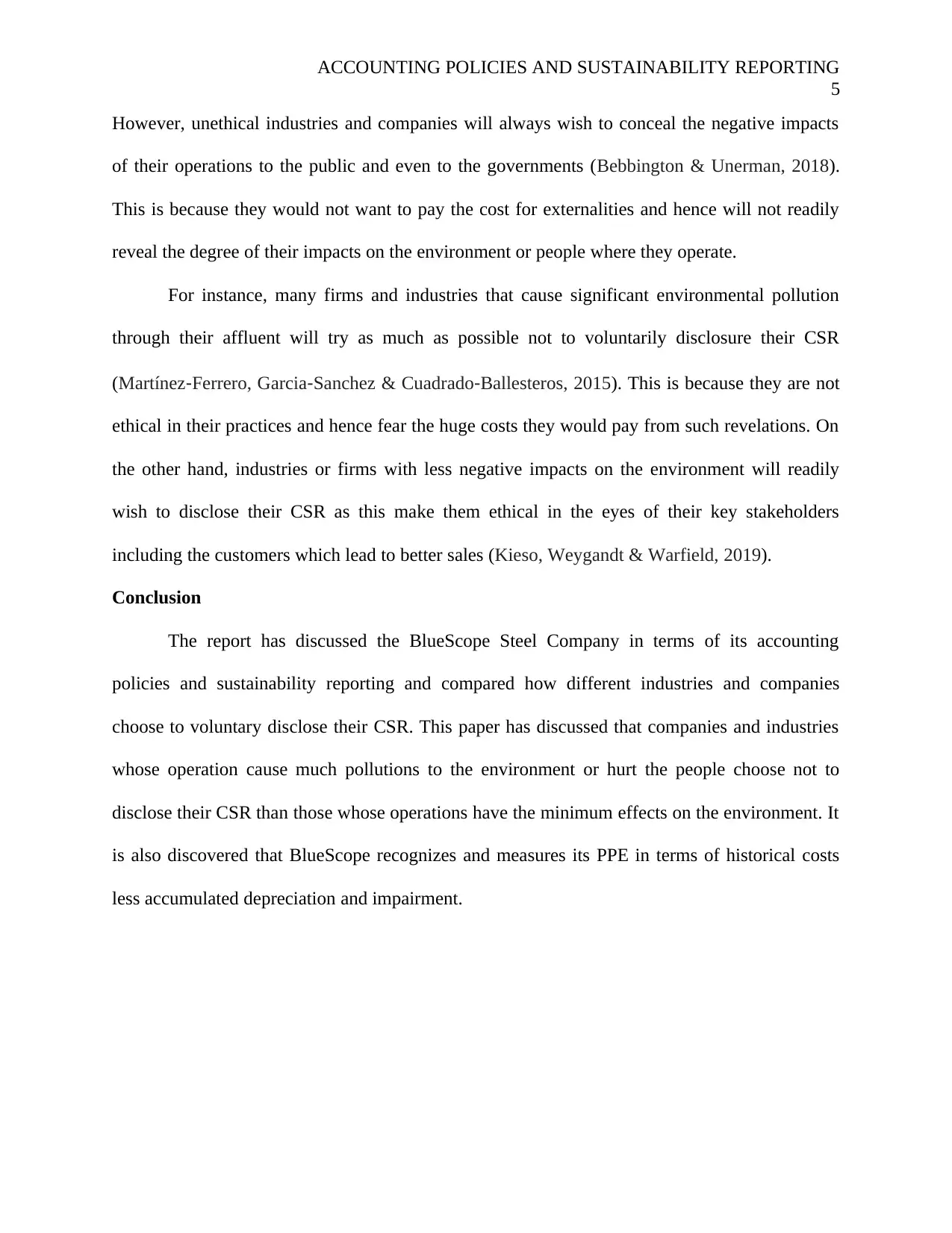
ACCOUNTING POLICIES AND SUSTAINABILITY REPORTING
5
However, unethical industries and companies will always wish to conceal the negative impacts
of their operations to the public and even to the governments (Bebbington & Unerman, 2018).
This is because they would not want to pay the cost for externalities and hence will not readily
reveal the degree of their impacts on the environment or people where they operate.
For instance, many firms and industries that cause significant environmental pollution
through their affluent will try as much as possible not to voluntarily disclosure their CSR
(Martínez‐Ferrero, Garcia‐Sanchez & Cuadrado‐Ballesteros, 2015). This is because they are not
ethical in their practices and hence fear the huge costs they would pay from such revelations. On
the other hand, industries or firms with less negative impacts on the environment will readily
wish to disclose their CSR as this make them ethical in the eyes of their key stakeholders
including the customers which lead to better sales (Kieso, Weygandt & Warfield, 2019).
Conclusion
The report has discussed the BlueScope Steel Company in terms of its accounting
policies and sustainability reporting and compared how different industries and companies
choose to voluntary disclose their CSR. This paper has discussed that companies and industries
whose operation cause much pollutions to the environment or hurt the people choose not to
disclose their CSR than those whose operations have the minimum effects on the environment. It
is also discovered that BlueScope recognizes and measures its PPE in terms of historical costs
less accumulated depreciation and impairment.
5
However, unethical industries and companies will always wish to conceal the negative impacts
of their operations to the public and even to the governments (Bebbington & Unerman, 2018).
This is because they would not want to pay the cost for externalities and hence will not readily
reveal the degree of their impacts on the environment or people where they operate.
For instance, many firms and industries that cause significant environmental pollution
through their affluent will try as much as possible not to voluntarily disclosure their CSR
(Martínez‐Ferrero, Garcia‐Sanchez & Cuadrado‐Ballesteros, 2015). This is because they are not
ethical in their practices and hence fear the huge costs they would pay from such revelations. On
the other hand, industries or firms with less negative impacts on the environment will readily
wish to disclose their CSR as this make them ethical in the eyes of their key stakeholders
including the customers which lead to better sales (Kieso, Weygandt & Warfield, 2019).
Conclusion
The report has discussed the BlueScope Steel Company in terms of its accounting
policies and sustainability reporting and compared how different industries and companies
choose to voluntary disclose their CSR. This paper has discussed that companies and industries
whose operation cause much pollutions to the environment or hurt the people choose not to
disclose their CSR than those whose operations have the minimum effects on the environment. It
is also discovered that BlueScope recognizes and measures its PPE in terms of historical costs
less accumulated depreciation and impairment.
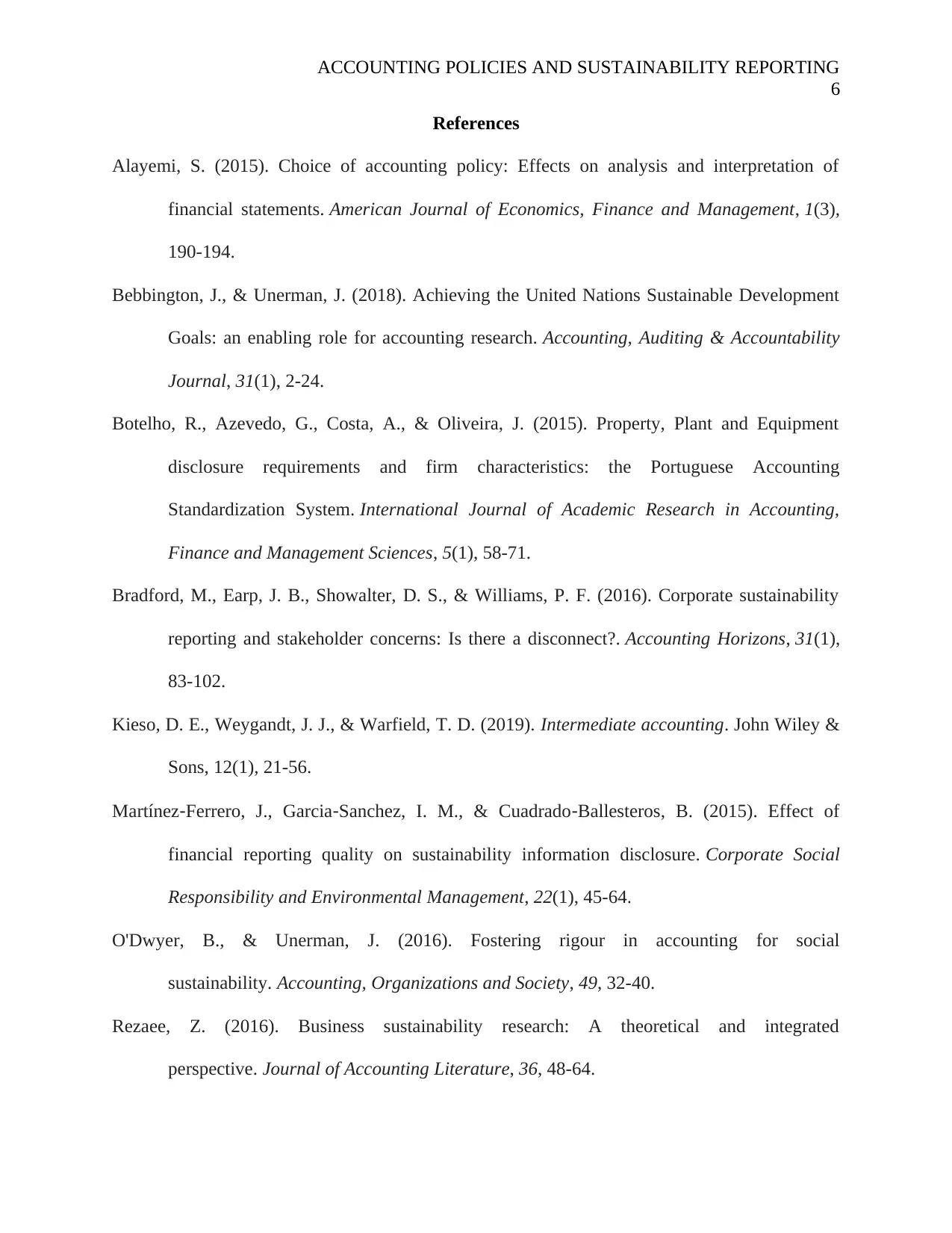
ACCOUNTING POLICIES AND SUSTAINABILITY REPORTING
6
References
Alayemi, S. (2015). Choice of accounting policy: Effects on analysis and interpretation of
financial statements. American Journal of Economics, Finance and Management, 1(3),
190-194.
Bebbington, J., & Unerman, J. (2018). Achieving the United Nations Sustainable Development
Goals: an enabling role for accounting research. Accounting, Auditing & Accountability
Journal, 31(1), 2-24.
Botelho, R., Azevedo, G., Costa, A., & Oliveira, J. (2015). Property, Plant and Equipment
disclosure requirements and firm characteristics: the Portuguese Accounting
Standardization System. International Journal of Academic Research in Accounting,
Finance and Management Sciences, 5(1), 58-71.
Bradford, M., Earp, J. B., Showalter, D. S., & Williams, P. F. (2016). Corporate sustainability
reporting and stakeholder concerns: Is there a disconnect?. Accounting Horizons, 31(1),
83-102.
Kieso, D. E., Weygandt, J. J., & Warfield, T. D. (2019). Intermediate accounting. John Wiley &
Sons, 12(1), 21-56.
Martínez‐Ferrero, J., Garcia‐Sanchez, I. M., & Cuadrado‐Ballesteros, B. (2015). Effect of
financial reporting quality on sustainability information disclosure. Corporate Social
Responsibility and Environmental Management, 22(1), 45-64.
O'Dwyer, B., & Unerman, J. (2016). Fostering rigour in accounting for social
sustainability. Accounting, Organizations and Society, 49, 32-40.
Rezaee, Z. (2016). Business sustainability research: A theoretical and integrated
perspective. Journal of Accounting Literature, 36, 48-64.
6
References
Alayemi, S. (2015). Choice of accounting policy: Effects on analysis and interpretation of
financial statements. American Journal of Economics, Finance and Management, 1(3),
190-194.
Bebbington, J., & Unerman, J. (2018). Achieving the United Nations Sustainable Development
Goals: an enabling role for accounting research. Accounting, Auditing & Accountability
Journal, 31(1), 2-24.
Botelho, R., Azevedo, G., Costa, A., & Oliveira, J. (2015). Property, Plant and Equipment
disclosure requirements and firm characteristics: the Portuguese Accounting
Standardization System. International Journal of Academic Research in Accounting,
Finance and Management Sciences, 5(1), 58-71.
Bradford, M., Earp, J. B., Showalter, D. S., & Williams, P. F. (2016). Corporate sustainability
reporting and stakeholder concerns: Is there a disconnect?. Accounting Horizons, 31(1),
83-102.
Kieso, D. E., Weygandt, J. J., & Warfield, T. D. (2019). Intermediate accounting. John Wiley &
Sons, 12(1), 21-56.
Martínez‐Ferrero, J., Garcia‐Sanchez, I. M., & Cuadrado‐Ballesteros, B. (2015). Effect of
financial reporting quality on sustainability information disclosure. Corporate Social
Responsibility and Environmental Management, 22(1), 45-64.
O'Dwyer, B., & Unerman, J. (2016). Fostering rigour in accounting for social
sustainability. Accounting, Organizations and Society, 49, 32-40.
Rezaee, Z. (2016). Business sustainability research: A theoretical and integrated
perspective. Journal of Accounting Literature, 36, 48-64.
⊘ This is a preview!⊘
Do you want full access?
Subscribe today to unlock all pages.

Trusted by 1+ million students worldwide
1 out of 6
Related Documents
Your All-in-One AI-Powered Toolkit for Academic Success.
+13062052269
info@desklib.com
Available 24*7 on WhatsApp / Email
![[object Object]](/_next/static/media/star-bottom.7253800d.svg)
Unlock your academic potential
Copyright © 2020–2025 A2Z Services. All Rights Reserved. Developed and managed by ZUCOL.





